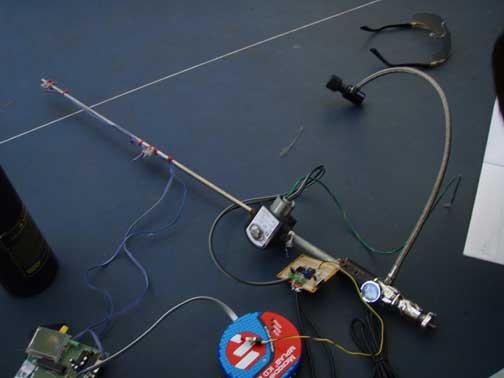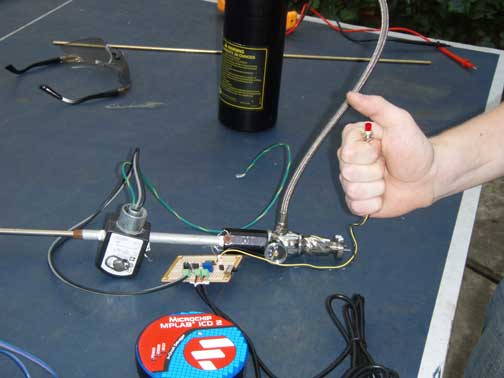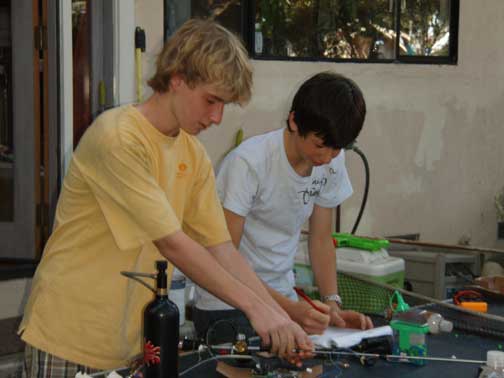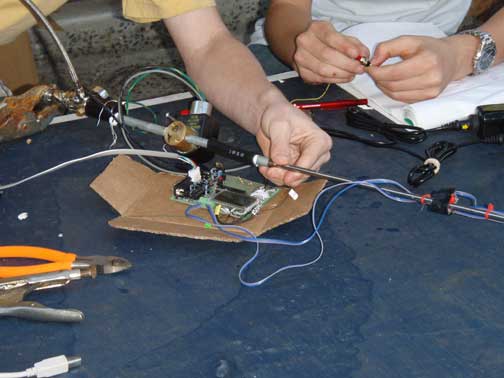*Offer expires 04/30/24 at 3 a.m. ET. Some exclusions apply.
*Offer expires 04/30/24 at 3 a.m. ET. Some exclusions apply.
by Trevor Foss and Beau Bayless
Copyright PyramydAir.com ©2008. All RightsReserved.
Note: The 2008 California Science & Engineering Fair included an airgun-related entry from Beau Bayless and Trevor Foss, eighth-grade students at All Saints' Episcopal Day School in Carmel. Their entry won first place in the Physics & Astronomy section. In a slightly different format than our usual articles, we present their project.
Objective
Our objective was to find how changing the air pressure of an air gun affects the average speed of the pellet. We thought that if you double the air pressure, the average speed will double, if you triple the air pressure, the average speed will triple, and so on.
Methods & materials
We constructed an air gun that would shoot pellets at variable pressures through a barrel with a sensor at the beginning and the end. Then we set the pressure to 100 psi and fired the air gun. We recorded the time that the pellet took to pass through the first and second sensors and used the formula Speed = Distance/Time to get the speed. We repeated those steps four more times and averaged the five speeds. We repeated that procedure, increasing the air pressure by 100 psi each time until we reached 500 psi.
| Gas pressure in PSI (pounds per square inch) | 100 | 200 | 300 | 400 | 500 |
| Velocity (meters per second) | 59.74 | 78.33 | 95.10 | 104.55 | 106.68 |
| 56.08 | 70.71 | 96.01 | 106.68 | 110.34 | |
| 58.83 | 88.39 | 91.44 | 103.94 | 106.68 | |
| 57.61 | 73.15 | 95.40 | 101.80 | 114.60 | |
| 58.22 | 72.54 | 94.79 | 110.03 | 106.07 | |
| Average velocity (meters per second) | 58.09 | 76.63 | 94.55 | 105.40 | 108.87 |
Results & discussion
Our graph (above) shows the average speed for each of the gas pressures. For 100 psi, the average speed was 58 meters per second; 200 psi produced 77 mps; 300 psi produced 95 mps; 400 psi produced 105 mps; and 500 psi produced 109 mps. We concluded that our hypothesis was wrong in the saying that doubling the psi would double the average speed. However, we discovered that although increasing the pressure increased the speed as the psi increased, the increase in the average speed decreased.
Data analysis & conclusion
Our experiment investigated how the change in the pressure (pounds/square inch) of an air gun affects the average speed of a pellet. We were trying to find out the relationship between the pressure of the airgun and the average speed of the pellet. Our graph shows the average speed for each of the gas pressures. For 100 psi, the average speed was 58 meters per second, 200 psi produced 77 mps, 300 psi produced 95 mps, 400 psi produced 105 mps and 500 psi produced 109 mps.
Between 100 psi and 200 psi, the average speed increased by 18.6 mps,between 200 psi and 300 psi the average speed increased by only 17.9 mps, between 300 psi and 400 psi the average speed increased by 10.8 mps, and between 400 psi and 500 psi the average speed increased by 3.4 mps. We think we got these results because the greatest change in pressure is between 100 psi and 200 psi. And, 200 psi is twice the pressure of 100 psi, while 300 psi is only 1.5 times as great as 200 psi, 400 psi is 1.3 times as great as 300 psi and 500 psi is 1.25 times as great as 400 psi. So, the increases in pressure were also proportionally less. We concluded that our hypothesis was wrong in saying that doubling the psi would double the average speed.
Our experiment is important because it tells people how fast their airsoft guns shoot. People can use this because most airsoft gun's speed is a guess based on distance and impact. This experiment can tell people how fast their airsoft guns really shoot and if airsoft manufacturers are lying about speed to increase sales.
We think we controlled our variables quite well. We used the same pellet size and mass, the same length of the barrel and the same type of sensors.
One variable that we did not expect was that we had to use a spit wad and a pellet. Since the pellets we used were transparent, the sensors did not register the pellet going past the sensors. To solve this problem, we added a small rolled up piece of paper for the sensors to register the speed. We tried to use the exact same sized wad, but maybe some of the wad sizes could have been slightly off.
If we were going to do this experiment again, we would do 20 shots per pressure and then average them. We would have also made sure that we used the exact same size spit wad with the pellet.

Trevor and Beau used the above tools for their project.



Buy With Confidence
Get FREE shipping on qualifying orders! Any order $150+ with a shipping address in the contiguous US will receive the option for free ground shipping on items sold & shipped by Pyramyd AIR during checkout. Certain restrictions apply.
Free shipping may not be combined with a coupon unless stated otherwise.
View Shipping Info
We work hard to get all orders placed by 12 pm EST out the door within 24 hours on weekdays
because we know how excited you are to receive your order.
Weekends and holiday shipping times will vary.
During busy holidays, we step our efforts to ship all orders as fast as possible,
but you may experience an additional 1-2 day delay before your order ships.
This may also happen if you change your order during processing.
View Shipping Times
It's important to know that due to state and local laws, there are certain restrictions for various products.
It's up to you to research and comply with the laws in your state, county, and city.
If you live in a state or city where air guns are treated as firearms you may be able to take advantage of our FFL special program.
U.S. federal law requires that all airsoft guns are sold with a 1/4-inch blaze orange muzzle
or an orange flash hider to avoid the guns being mistaken for firearms.
View Shipping Restrictions
Get the most out of your equipment when you work with the expert technicians at Pyramyd AIR. With over 25 years of combined experience, we offer a range of comprehensive in-house services tailored to kickstart your next adventure.
If you're picking up a new air gun, our team can test and tune the equipment before it leaves the warehouse. We can even set up an optic or other equipment so you can get out shooting without the hassle. For bowhunters, our certified master bow technicians provide services such as assembly, optics zeroing, and full equipment setup, which can maximize the potential of your purchase.
By leveraging our expertise and precision, we ensure that your equipment is finely tuned to meet your specific needs and get you ready for your outdoor pursuits. So look out for our services when shopping for something new, and let our experts help you get the most from your outdoor adventures.
View Service Info
Shop and purchase with confidence knowing that all of our air guns (except airsoft) are protected
by a minimum 1-year manufacturer's warranty from the date of purchase unless otherwise noted on the product page.
A warranty is provided by each manufacturer to ensure that your product is free of defect in both materials and workmanship.
View Warranty Details
Didn't get what you wanted or have a problem? We understand that sometimes things aren't right and our team is serious about resolving these issues quickly. We can often help you fix small to medium issues over the phone or email.
If you need to return an item please read our return policy.
Learn About Returns
Get FREE shipping on qualifying orders! Any order $150+ with a shipping address in the contiguous US will receive the option for free ground shipping on items sold & shipped by Pyramyd AIR during checkout. Certain restrictions apply.
Free shipping may not be combined with a coupon unless stated otherwise.
View Shipping Info
Want More?
Join Our Email List for News and Deals!
Join the Pyramyd AIR mailing list: Our e-mails are filled with new products, deals, sneak peeks, tips and tricks, contests and more - sign up today!
Text JOIN to 91256 and get $10 OFF Your Next $50+ Order!
* By providing your number above, you agree to receive recurring autodialed marketing text msgs (e.g. cart reminders) to the mobile number used at opt-in from Pyramyd AIR on 91256. Reply with birthday MM/DD/YYYY to verify legal age of 18+ in order to receive texts. Consent is not a condition of purchase. Msg frequency may vary. Msg & data rates may apply. Reply HELP for help and STOP to cancel. See Terms and Conditions & Privacy Policy.